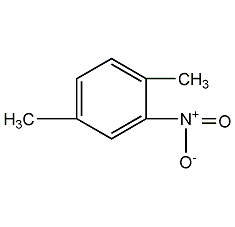
Structural formula
| Business number | 020X |
|---|---|
| Molecular formula | C8H9NO2 |
| Molecular weight | 151.16 |
| label |
1,4-dimethyl-2-nitrobenzene, 2-nitro-1,4-xylene, 2-Nitro-p-xylene, 1,4-Dimethyl-2-nitrobenzene, 2-Nitro-p-xylene |
Numbering system
CAS number:89-58-7
MDL number:None
EINECS number:201-920-7
RTECS number:ZE4686600
BRN number:None
PubChem ID:None
Physical property data
1. Properties: yellow liquid [1]
2. Melting point (℃): -25[2]
3. Boiling point (℃): 240[3]
4. Relative density (water=1): 1.32[4 ]
5. Octanol/water partition coefficient: 2.91[5]
6. Solubility: insoluble in water, soluble in Ethanol, ether. [6]
Toxicological data
1. Acute toxicity[7] LD50: 2440mg/kg (rat oral)
2. Irritation No information available
Ecological data
1. Ecotoxicity No data available
2. Biodegradability No data available
3 .Non-biodegradability No information available
4. Other harmful effects[8] This substance is harmful to the environment and should be treated with special Pay attention to water pollution.
Molecular structure data
1. Molar refractive index: 42.44
2. Molar volume (cm3/mol): 133.8
3. Isotonic specific volume (90.2K ): 338.0
4. Surface tension (dyne/cm): 40.7
5. Polarizability (10-24cm3): 16.82
Compute chemical data
1. Reference value for hydrophobic parameter calculation (XlogP): 2.5
2. Number of hydrogen bond donors: 0
3. Number of hydrogen bond acceptors: 2
4. Number of rotatable chemical bonds: 0
5. Number of tautomers: none
6. Topological molecule polar surface area 45.8
7. Number of heavy atoms: 11
8. Surface charge: 0
9. Complexity: 153
10. Number of isotope atoms: 0
11. Determine the number of atomic stereocenters: 0
12. Uncertain number of atomic stereocenters: 0
13. Determine the number of chemical bond stereocenters: 0
14. Number of uncertain chemical bond stereocenters: 0
15. Number of covalent bond units: 1
Properties and stability
1. Stability[9] Stable
2. Incompatible substances[10] Strong oxidizing agent, strong alkali
3. Conditions to avoid contact[11] Heating
4. Polymerization hazard[12] No polymerization
5. Decomposition products[13] Nitrogen oxidation Object
Storage method
Storage Precautions[14] Store in a cool, ventilated warehouse. Keep away from fire and heat sources. Keep container tightly sealed. They should be stored separately from oxidants, alkalis, and food chemicals, and avoid mixed storage. Equipped with the appropriate variety and quantity of fire equipment. The storage area should be equipped with emergency release equipment and suitable containment materials.
Synthesis method
None
Purpose
1. Used in organic synthesis. [15]


